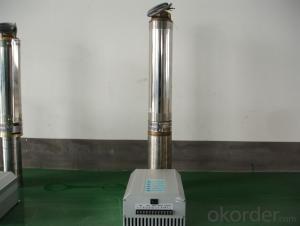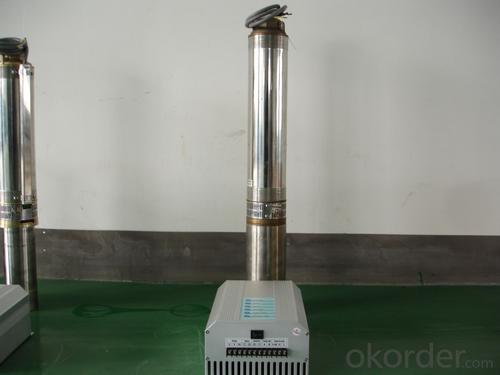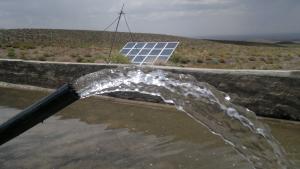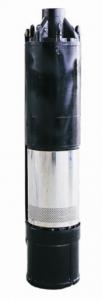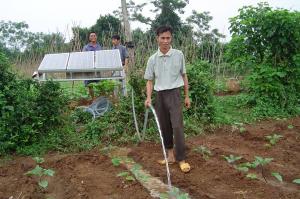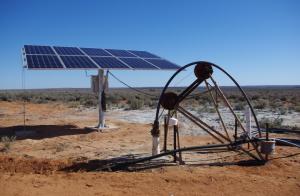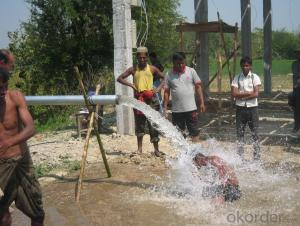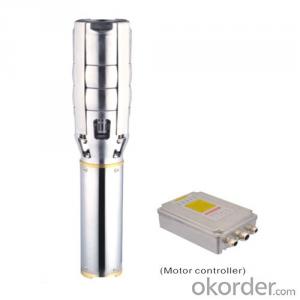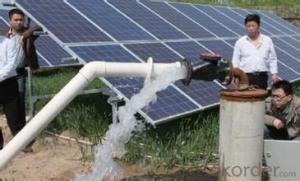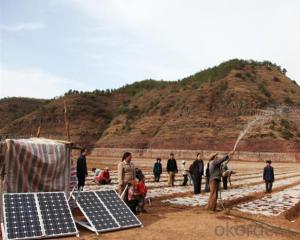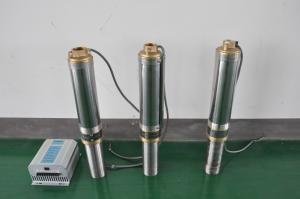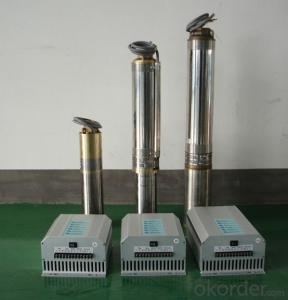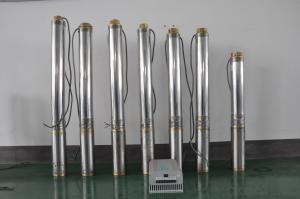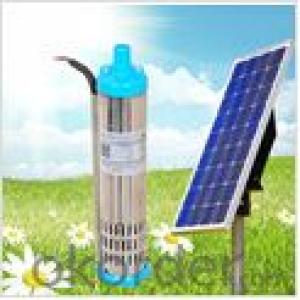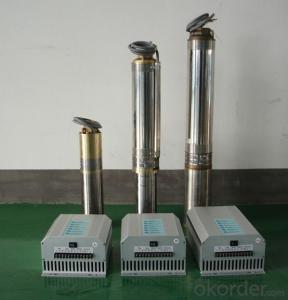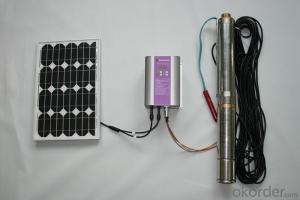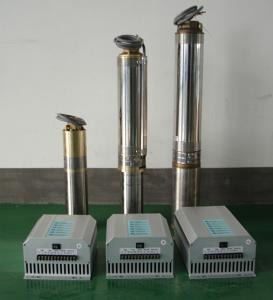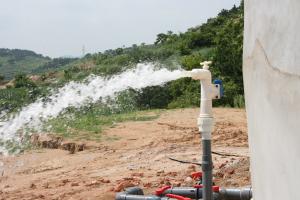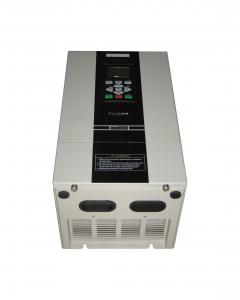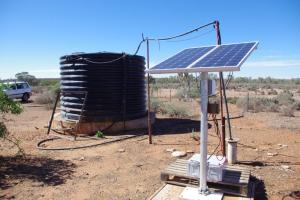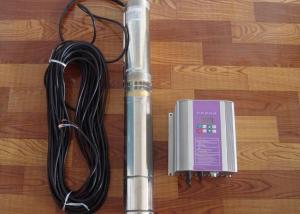1HP Solar Pump Price DC Submersible Pump
- Loading Port:
- China Main Port
- Payment Terms:
- TT OR LC
- Min Order Qty:
- -
- Supply Capability:
- -
OKorder Service Pledge
OKorder Financial Service
You Might Also Like
Item Description :
This superb new addition to our solar fountain range comes with a 10w solar panel,and a powerful fountain pump that is capable of producing fountains of up to 2m in height. As well as being easy to set up and use.Instruction manual is supplied for assembly and maintenance.
Solar Fountain Key Features :
Powered by direct sunlight
No high voltage electric mains required
Safe for children
Max. height of fountain: 2M
Max. flow capacity: 800 L/H(176 GAL)
10W Polycrystalline solar panel included
18V DC brushless pump
Solar Pump Features :
Can produce fountains up to : 2M (tube height) 1.4M (fountain height)
Comes with multiple nozzle accessories
Cable Length : 5M
Solar Panel Features :
10W peak power.
Polycrystalline highly efficient solar panel
Comes mounted in aluminium frame
Comes with ground stake and rotating knob so you can angle your panel toward the sun
What You Will Get :
10W solar panel
Solar pump
Ground Sake
Nozzle accessories
Precautions :
DO NOT alter or change the product itself or its components
Operate pump in freshwater only, never above 50 degrees celsius
Keep away from flammable liquids
Do not connect to any other power supply other than the included
- Q: Can a solar pump be used for water supply in tea estates?
- Yes, a solar pump can be used for water supply in tea estates. Solar pumps use energy from the sun to power the pump, which can effectively draw water from underground sources or nearby water bodies. This sustainable and cost-effective solution can provide a reliable water supply for irrigation and other needs in tea estates.
- Q: Can a solar pump be used for water supply in wildlife sanctuaries or conservation areas?
- Yes, a solar pump can certainly be used for water supply in wildlife sanctuaries or conservation areas. Solar pumps are an environmentally friendly and sustainable solution as they harness energy from the sun to power the pump, eliminating the need for fossil fuels or electricity. This makes them ideal for remote areas where traditional power sources are not readily available. Additionally, solar pumps are quiet, low-maintenance, and can efficiently pump water from various sources, ensuring a reliable water supply for wildlife in these protected areas.
- Q: Can a solar pump be used in areas with low water tables?
- Yes, a solar pump can be used in areas with low water tables. Solar pumps are designed to utilize solar energy to draw water from various sources such as wells, boreholes, or reservoirs. While low water tables may pose challenges, solar pumps can still be effective by employing appropriate pumping techniques, such as using submersible pumps or adjusting the depth of the pump intake. Additionally, efficient water management practices and conservation measures can be implemented to ensure sustainable water usage in areas with low water tables.
- Q: Can a solar pump be used for dewatering purposes?
- Yes, a solar pump can be used for dewatering purposes. Solar pumps are designed to extract water from a source and can be used for various applications, including dewatering flooded areas, drainage systems, or pumping water from wells or underground sources. They are an efficient and environmentally friendly solution for dewatering needs, as they utilize solar power to operate, eliminating the need for electricity or fuel.
- Q: How does the installation complexity of a solar pump compare to a traditional electric pump?
- Compared to a traditional electric pump, a solar pump is generally less complex to install. This is primarily because solar pumps do not require an elaborate electrical setup or a connection to the power grid. Solar pumps utilize photovoltaic panels to convert sunlight into electricity, which is then utilized to power the pump. The installation process typically involves placing the solar panels in a location that receives optimal sunlight exposure and ensuring a secure mounting system. The panels are then connected to the pump, often through a controller or inverter that regulates the flow of power. In contrast, traditional electric pumps necessitate a dedicated power source, usually obtained from the electrical grid. This involves more intricate electrical wiring and connections. It may also require the assistance of an electrician to correctly install the pump and ensure compliance with local electrical codes. Additionally, traditional electric pumps often require a substantial amount of infrastructure, such as power lines and transformers, which can contribute to the complexity of the installation. Furthermore, solar pumps are generally more modular and portable in comparison to traditional electric pumps. This allows for easier installation and relocation if necessary, without the need for extensive rewiring or modifications to the infrastructure. Overall, thanks to the simplicity of the solar power system and the absence of reliance on the electrical grid, the installation complexity of a solar pump is generally lower than that of a traditional electric pump.
- Q: How do I ensure the longevity of the solar panels used in a solar pump system?
- To ensure the longevity of the solar panels used in a solar pump system, it is important to follow a few key practices. Firstly, regular maintenance is crucial, including cleaning the panels to remove any dirt or debris that may accumulate. Additionally, inspecting the panels for any signs of damage or wear and tear is important, and addressing any issues promptly can help prevent further damage. It is also essential to ensure that the panels are installed in an optimal location where they receive maximum sunlight exposure and are not obstructed by shading. Lastly, protecting the panels from extreme weather conditions such as hail or heavy snowfall can also help prolong their lifespan.
- Q: How does the efficiency of a solar pump change over time?
- The efficiency of a solar pump can change over time due to various factors. Initially, when a solar pump is new and properly maintained, it operates at its highest efficiency. However, over time, the efficiency of the pump may gradually decrease. One factor affecting the efficiency of a solar pump is the degradation of the solar panels. Solar panels are exposed to the elements and can suffer from wear and tear over time. Dust, dirt, and other environmental factors can accumulate on the panels, reducing their ability to absorb sunlight effectively. Additionally, the efficiency of solar panels can decline as they age, leading to lower power output. Another factor that can impact the efficiency of a solar pump is the degradation of the pump's motor and other mechanical components. Like any mechanical system, a solar pump is subject to wear and tear. Over time, the bearings may wear out, the seals may deteriorate, and the overall performance may decline. This can result in reduced pumping capacity and overall efficiency. Furthermore, the performance of the solar pump can be affected by changes in the surrounding environment. For instance, if nearby trees or structures grow taller, they may cast shadows on the solar panels, reducing their exposure to sunlight. Similarly, changes in water levels or quality can affect the pump's efficiency. If the water source becomes contaminated or the water table drops, the pump may have to work harder to maintain the desired flow rate, decreasing its efficiency. To maintain or improve the efficiency of a solar pump over time, regular maintenance and monitoring are crucial. Cleaning the solar panels, inspecting and replacing worn-out components, and ensuring proper alignment with the sun are essential maintenance practices. Moreover, staying updated with the latest technological advancements can help in upgrading and optimizing the pump's efficiency. Overall, the efficiency of a solar pump can change over time due to factors such as solar panel degradation, mechanical wear and tear, changes in the environment, and aging components. To ensure optimal performance, regular maintenance, and monitoring are necessary.
- Q: Can solar pumps be used for livestock watering?
- Yes, solar pumps can indeed be used for livestock watering. Solar-powered water pumps are an excellent solution for providing a reliable and sustainable water source for livestock. These pumps use solar energy to power the water pump, eliminating the need for electricity or fuel. They are cost-effective, environmentally friendly, and can be easily installed in remote locations where traditional power sources might not be available. Overall, solar pumps are a great choice for livestock watering, promoting self-sufficiency and reducing operating costs for farmers.
- Q: What is the maximum operating pressure of a solar pump?
- The maximum operating pressure of a solar pump can vary depending on the specific model and design. However, in general, most solar pumps have a maximum operating pressure ranging from 100 to 150 pounds per square inch (psi).
- Q: How does a solar pump handle water with high levels of salinity?
- A solar pump can handle water with high levels of salinity by utilizing a reverse osmosis (RO) system. The RO system effectively removes the salt and other impurities from the water, making it suitable for various purposes such as irrigation or drinking. The solar pump powers the RO system, creating pressure to push the water through a semi-permeable membrane, which separates the salts from the water molecules. As a result, the solar pump ensures that the water being pumped is free from high levels of salinity, providing a reliable and sustainable solution for pumping saline water.
Send your message to us
1HP Solar Pump Price DC Submersible Pump
- Loading Port:
- China Main Port
- Payment Terms:
- TT OR LC
- Min Order Qty:
- -
- Supply Capability:
- -
OKorder Service Pledge
OKorder Financial Service
Similar products
Hot products
Hot Searches
Related keywords
